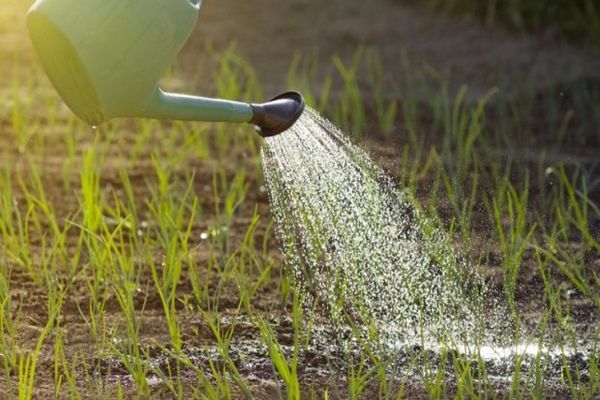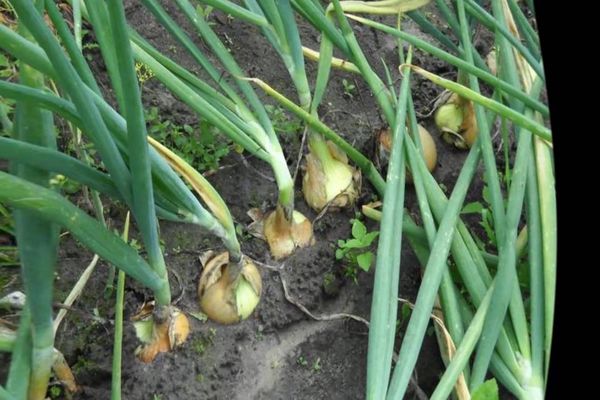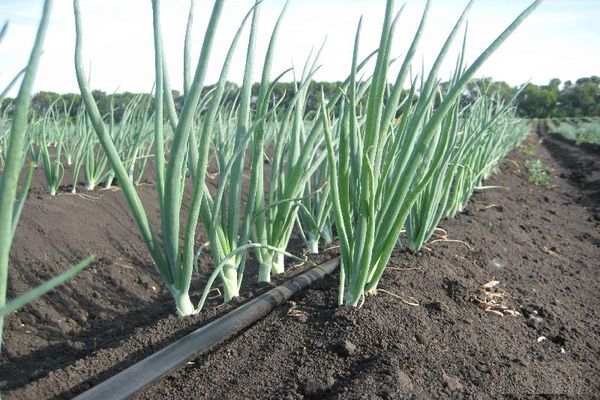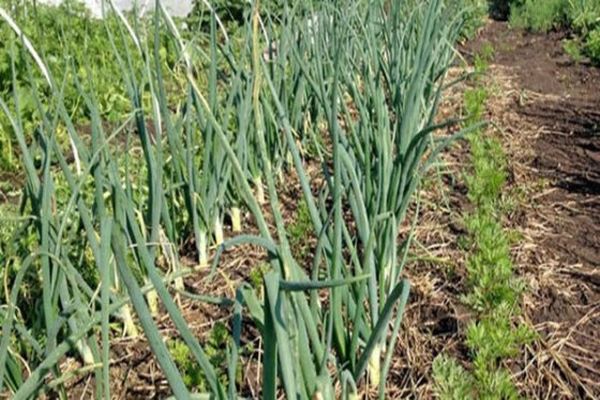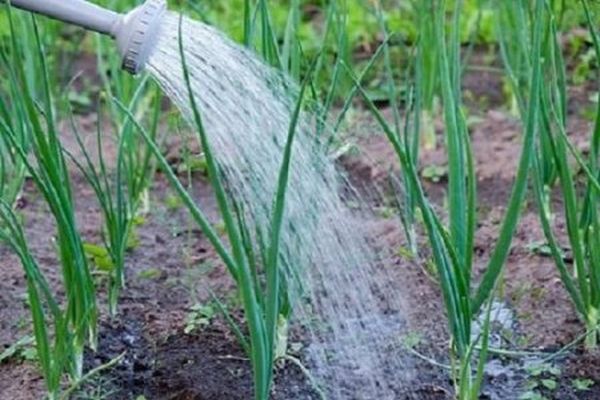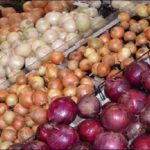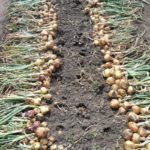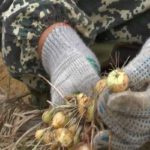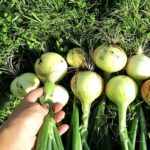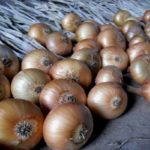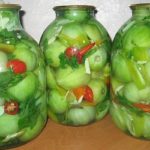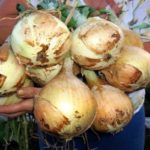Watering onions with salt is an ancient way to combat onion flies. Rarely does anyone use chemicals to protect them from pests. The heads are capable of accumulating harmful substances, so preference is given to traditional methods of protection, they are less toxic.
Signs of infection
Yellowed feather tips are the first sign of infection. The onion fly season begins during the cherry blossom period. At this time the earth had already warmed up, the gardeners planted the beds with onions and garlic. Flies are small (7 mm) gray insects that lay eggs near any bulbous plants.
A week later, larvae emerge from the eggs - the main enemies of onions.It is the worm-like larvae that cause the damage; with their hook-shaped jaws they are capable of eating away most of the onion pulp. After 3 weeks, the pupation process begins, and after another 3 weeks a new generation of flies appears. One insect makes 2 clutches of 60 eggs each during the summer.
If the onion beds are not cultivated, then the picture will become sad by mid-summer:
- the heads practically do not grow;
- the feather is limp, slightly colored, curled;
- the affected heads are soft, smell bad, and damage is visible in the bottom area.
Infection occurs through the ground, the larvae damage the lower part of the head, penetrate inside, and eat away the pulp. You can lose your entire turnip harvest if you plant the seedlings on soil that is infested with flies.
An ancient recipe for onion fly larvae
The saline solution is prepared from ordinary tap water and table salt. Treatment alone will not solve the problem. To get the effect you need at least three of them. The salt/water proportions change each time, the salt concentration gradually increases.
| Processing number | Amount of salt, g | Amount of water, l |
| 1 | 300 | 10 |
| 2 | 450 | 10 |
| 3 | 600 | 10 |
You should not increase the number of treatments or the salt concentration above the specified level, as this can harm the soil. For onions, its excess is also not needed.
How to water onions to prevent onion flies?
The beds are watered with salt water in the early evening, precisely early, since after 4 hours you need to water the onions with regular water. This measure is necessary to preserve soil fertility, thus protecting it from salinization. It is recommended to water the onions with salt not at the top, but carefully around each head, one needs a little more than a glass.
Water for the first time when the young feather grows to 5–8 cm.Just at this time, the first generation of larvae will be born from the eggs. The second treatment is carried out three weeks later. The salt concentration in the solution increases.
In the interval between watering with saline solution, do not forget about the onions; you need to help them with the following measures:
- pick off yellowed feathers;
- loosen the soil after each watering and sprinkle it with ash, hot red pepper or tobacco dust;
- pull out and destroy severely affected heads;
- feed the plantings.
Prepare the salt solution for the third time after 2 weeks, increasing the salt concentration to 600 g. You can refuse the third watering against onion flies if by this time the onions have acquired a healthy appearance.
You need to know which fertilizers are best to use to increase the immunity of onions. The soil is important for its health. In the middle zone, in most places the soil is peaty or soddy-podzolic. Once every 3–5 years it must be limed in order to get a good turnip harvest.
Feeding
Those who believe that onions do not need fertilizing are mistaken. Fertilizers are necessary both during soil preparation and during the growing season in summer. In autumn, the soil is filled with well-rotted humus or compost. Organic consumption: per 1 sq. m ridge 1 bucket.
The use of mineral fertilizers on depleted soils will not hurt. You need to use the standard set in the fall:
- urea;
- superphosphate;
- potassium nitrate.
After adding a mineral complex to the soil in the fall, in the summer it is enough to feed the crop with nitrogen fertilizers. Urea is suitable; 10 liters require 10 g. A bucket of solution is enough for 2 square meters. m ridges.
Nitrogen fertilizers are fed when the feather reaches 10–15 cm in height.Phosphorus and potassium fertilizers are applied a second time, and feeding is carried out 10 days after the first.
Prevention
There will be benefits from treating onions with salt, even if your onion bed is vigorously turning green, there are no signs indicating the presence of larvae. Agronomists advise carrying out preventive watering of onions. The main thing is not to violate the recommended frequency of treatments and adhere to the correct proportions when preparing the solution.
Crop rotation is a means that helps reduce the onion fly population in the garden and prevents its reproduction. Every season you need to plant onions in a new place. In late autumn, fight against overwintering larvae; they remain at a depth of 20 cm. It is necessary to dig up the soil without breaking up lumps. Pests end up on the surface, most of them freeze out.
Soaking the seedlings in a manganese solution before planting is the second no less important preventive measure. Some people prefer salt to manganese. You need 1 glass for a bucket of water. The onions are kept in a salt solution for 12 hours. The salty taste of the husk repels pest larvae.
The smell of carrot tops and marigolds repels flying insects well. Experienced gardeners practice combined planting. Carrots planted along the perimeter of the onion ridge interrupt the smell of the onions with their smell, thereby misleading the pest. The onion, in turn, repels the carrot fly from the root crop.
Reviews
Polina: “Before planting, I soak the sets in a solution of potassium permanganate. I dig a bed in a new place every year. Every 2-3 weeks I water the onions with salt water. I sprinkle the entire surface of the ridge with salt mixed with soda, despite watering with salt, sick plants still appeared. I take 1 part baking soda and 2 parts salt.”
Eleanor: “I have little experience as a gardener; my dacha appeared three years ago. The first year I bought and planted the sets, there was nothing to clean, all the heads were eaten by the larvae of the onion fly. The next year, grandma advised us to water the beds with salt. The advice helped, we’ll eat our turnips until spring.”
Oleg: “The dacha is old, so the soil is heavily contaminated with onion fly larvae. Not only onions suffer, but also garlic. I read about the benefits of salt against onion flies, tried the original recipe in my garden, the result was convincing - the percentage of crops lost has decreased. Now processing onions with salt is a mandatory event along with the autumn sowing of green manure. I was afraid that the heads would be small because of the salt, but it turned out to be in vain. Turnips and garlic grow large and store well.”
Conclusion
In beds watered with salt, turnips suffer less from the invasion of onion fly larvae. Every year, by moving the onion bed to a new location, they prevent salinization of the soil and its infestation with a large number of pests. Salt, crop rotation, fertilizing, and other preventive measures allow you to grow high-quality heads.


